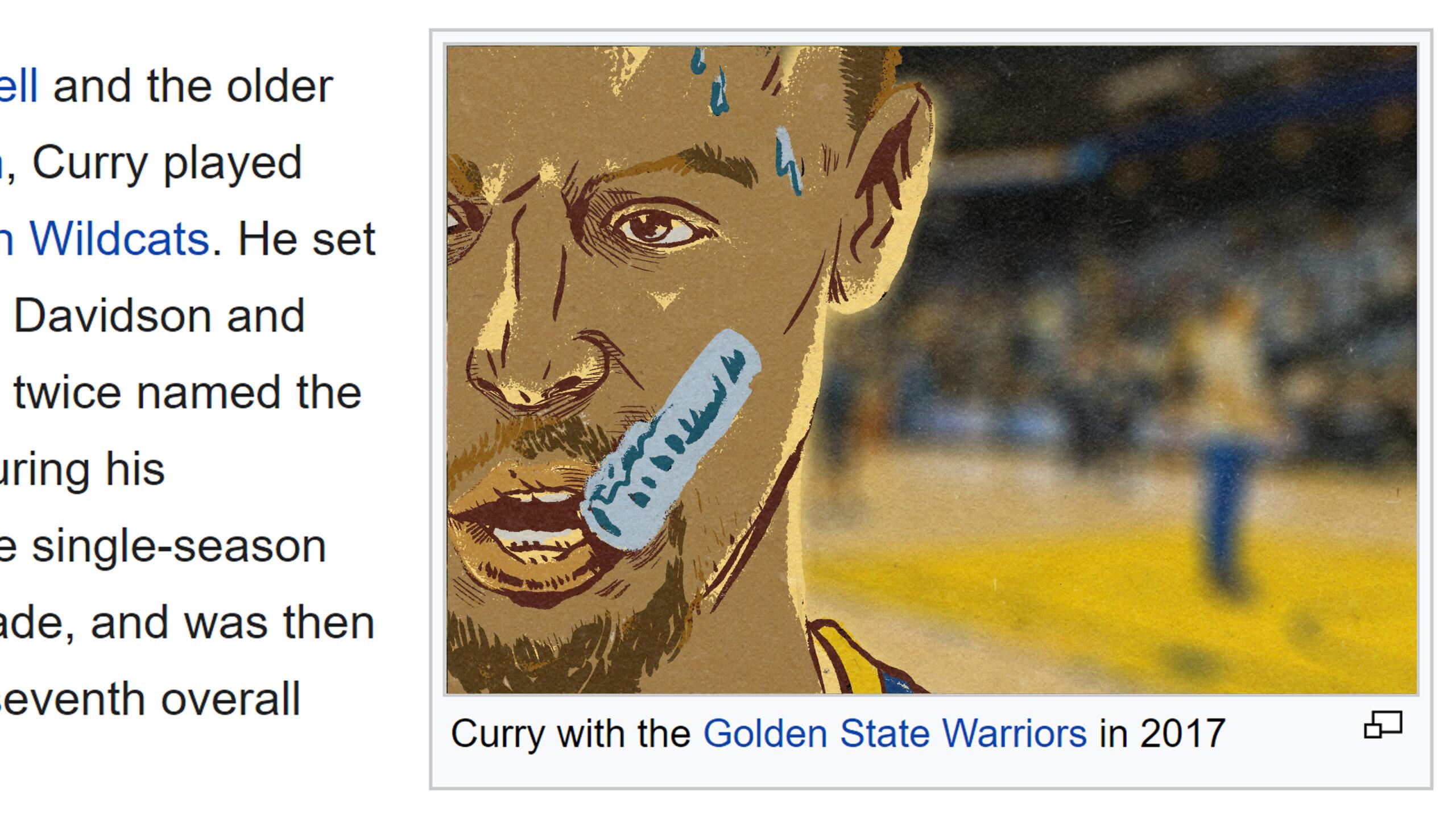Wikipedia’s Best Worst NBA Photos Are Modern Art
The internet’s free encyclopedia is a testament to our desire for shared knowledge—and grainy, horrible pictures of Larry BrownEditor’s note: Today, The Ringer celebrates the 20th anniversary of Wikipedia. Here’s an article on the wonders of Wikipedia’s NBA images, which was originally published in July 2017.
I’d estimate that I visit 10 different Wikipedia pages on an average night. Sometimes I’m looking for specific facts (how many games has Andorra’s soccer team won? What is the Oort cloud? Were there four guys and three girls in S Club 7, or were there three guys and four girls?), and sometimes I’m looking for general knowledge (what are the tenets of existentialism? What happened in the Battle of El Alamein? What was the plot of Spice World?). Almost always, somebody has lovingly produced the information I’m seeking. (Wikipedia doesn’t have an explanation for why I regularly search for info on 1990s Britpop.) The internet can often feel like it brings out the worst in people; that it’s impossible to escape the racists and trolls. Yet Wikipedia gave total power to the people, and instead of developing into a minefield of hate, people came together to create the most comprehensive encyclopedia in the history of the planet.
And it’s free to use, and created for free. Part of that freeness means that Wikipedia does not pay for licensed photographs, which for the most part works out fine. Want to know what a finch looks like? Here. Someone took beautiful pictures of finches, and a Wikipedia user uploaded them so people could use them as a resource. Want to know what humans look like? Here; all humans look like those two people. Between user shots and images in the public domain, Wikipedia offers great pictures of almost everything, from Mount Kilimanjaro to quartz, Michelangelo’s Pietà to Ja Rule.
One subject it doesn’t offer great photos of is basketball players. Given the pace at which the sport is played, taking non-blurry shots usually requires photographers to be close to the action and to have expensive cameras. As such, most of the best basketball photos are licensed by services like Getty Images. There are some high-level photographers who take incredible shots of players and upload them for free — check out the pages of LeBron James, Steph Curry, Carmelo Anthony, Markieff Morris, and Mike Miller — but not many. (All five player pictures linked to above were taken by the same man: Keith Allison, a freelance photographer who lives in Baltimore and uploads his best shots to Flickr. If you see a professional-looking image on an NBA player’s Wiki page, there is a good chance it’s Allison’s work. On a whim, I checked the Chicago Bulls’ roster; four of the 12 players under contract have Wikipedia pictures taken by Allison.)
Some NBA Wikipedia photos are as distant, grainy, and ugly as something I could take on my iPhone. Some come from the instances when fans run into players off the court and snap shots then. (Here is Darius Miles, and here is the uncropped photo of Darius Miles with a guy giving two thumbs up that will represent Miles for the foreseeable future.) This Wiki photo problem is an issue for a handful of current NBA players — such as Taj Gibson, Wilson Chandler, and Dahntay Jones — but the most doomed players are those who retired a short time ago, after it became feasible for people to bring cameras to games and upload pictures online, but before Wikipedia users recognized the need for high-quality photos on each page.
Until March 2016, this was the main picture on the Wikipedia page for onetime All-Star Shareef Abdur-Rahim:

This is a literal profile picture — a picture that captures only Abdur-Rahim’s profile. His ear looks like some sort of weird mollusk; we see about 2 inches of his neck before an unidentified object juts in. The photo is of such poor quality that Abdur-Rahim looks like those cliffs that old prospectors decided vaguely resembled a human face. This shot was cropped from a larger image hosted on Flickr:
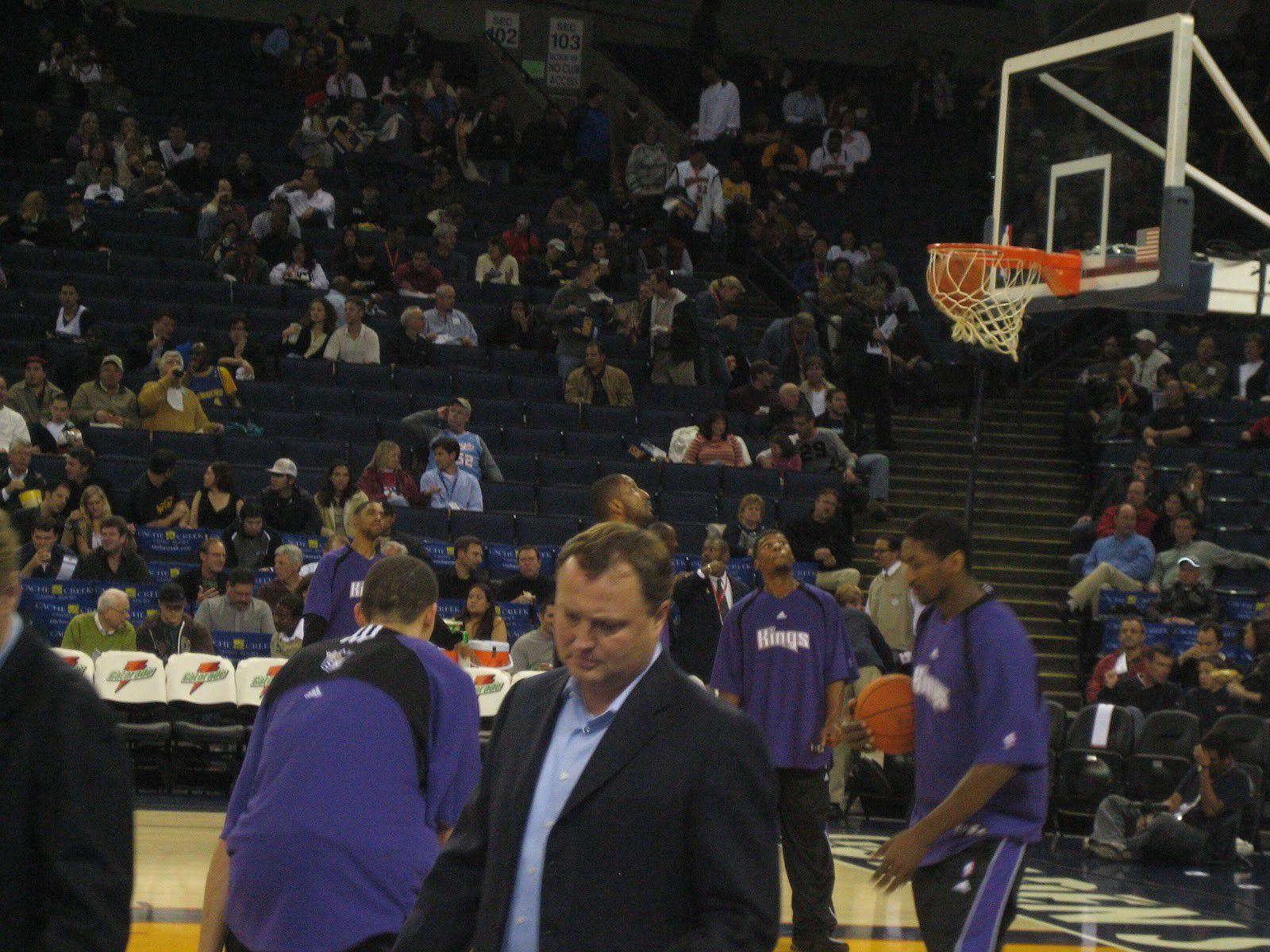
Can you see Shareef? Surely you see Ron Artest — before he was known as Metta World Peace. There’s Ronnie Price near the basket, and Jason Hart taking a jumper. Still can’t find our guy? Look at the man in the unbuttoned jacket who dominates the frame. Now look directly above his head.
There is the sliver of Abdur-Rahim’s head that a Wikipedia user saw, leading them to think, "Finally! A picture of Shareef Abdur-Rahim!" Ninety percent of his body is obscured — you may identify the unbuttoned jacket man’s hair as the unidentified object in the original thumbnail. If you took this photo as an attempt to capture a picture of Abdur-Rahim, you’d likely delete it and try again. But on July 10, 2015, nine years after it was uploaded to Flickr, this shot became the web’s defining image of Abdur-Rahim.
Sadly, this picture is now gone. Less than a year after it was uploaded to Wikipedia, another user removed it, offering the simple explanation, "This picture just diminishes the quality of the article." But I found it strangely endearing. While it’s hard to argue that such a legitimately horrendous image improved the quality of the site, it represented someone’s attempt to add to the world’s collective database of knowledge. That person’s failure is noble, and hilarious, and beautiful. Another user was randomly motivated to enhance the Wikipedia profile of Steve Francis, and searched the public domain for a legally usable photo. That person ended up with this.
Over the years, I’ve become obsessed with finding the most inexplicable NBA photos on Wikipedia, to the point that I starting saving my favorites. Now, I’d like to present my findings and chronicle the best worst NBA Wikipedia pictures for all of posterity.
Joey Graham
I always thought Graham was a solid defender. That was his reputation when he played at Oklahoma State, and later with the Raptors, Nuggets, and Cavaliers. If his Wikipedia profile picture is any indication, Graham also frequently tried to swallow food without chewing it while on the court.
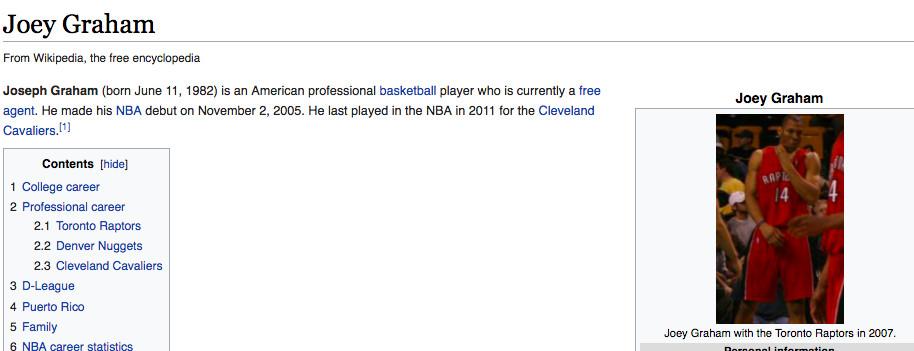
It’s tough to derive any emotion from the few pixels that make up his face — there’s no real evidence that Graham has a mouth, and it appears that there’s a wormhole to another galaxy located below his nose. But he somehow looks upset, even if I can’t fully explain why.
Shandon Anderson
Anderson was a youngster when he helped the late 1990s Jazz reach the NBA Finals and a veteran when he helped the 2005–06 Heat win the title. Consistent throughout his career was his unstoppable butt. That’s why his Wikipedia picture completely ignores the front side of his body.
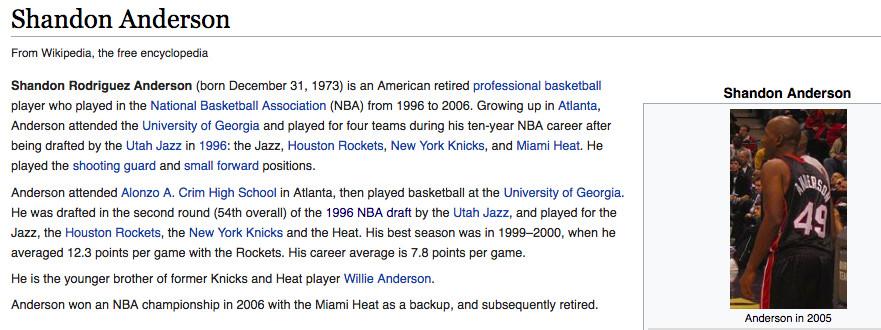
There are blurrier photos used on NBA player pages, but this one takes the cake for having the least amount of face visible. We get an ear, a cheekbone, a nose, and negative space that implies a mouth and an eye socket. We can’t, however, see Anderson’s mouth or eyes.
Michael Doleac
Doleac wasn’t the most important figure in the Heat’s 2005–06 NBA title run; he was the team’s third-string center behind Shaquille O’Neal and Alonzo Mourning. Given his lack of prominence and his height, he stood in the back of the team’s White House photo. When that picture was cropped, we got just his shoulders and head. Well … about three-quarters of his head.

White House visits make for great team photos. For thumbnail-size photos of individuals, that’s not always the case. But pictures taken by federal employees as part of their official duties are part of the public domain, so many NBA players have White House shots on their Wikipedia profiles. The Bulls visited the White House in 2009 to meet longtime fan Barack Obama, and it produced one picture that has been cropped to be the main image on a whopping seven Wiki pages: Lindsey Hunter, Anthony Roberson, Del Harris, Bernie Bickerstaff, John Paxson, Mike Wilhelm, and Bob Ociepka.
Doleac’s photo stands out, though. Most White House pictures feature players smiling. They’re happy to be champions, or to see the president, and they’re aware a photo is being taken. In this original image, the Heat are laughing with President George W. Bush: Pat Riley is smiling, Shaq is smiling, Mourning is smiling, Udonis Haslem is smiling, Dorell Wright is smiling, Jason Kapono is smiling — and somehow Doleac is making that face. I like to think he’s licking his lips like a cartoon character because he just smelled a freshly baked pie on a windowsill and doesn’t yet realize the pie is part of a trap laid by his cartoon nemesis.
Mardy Collins
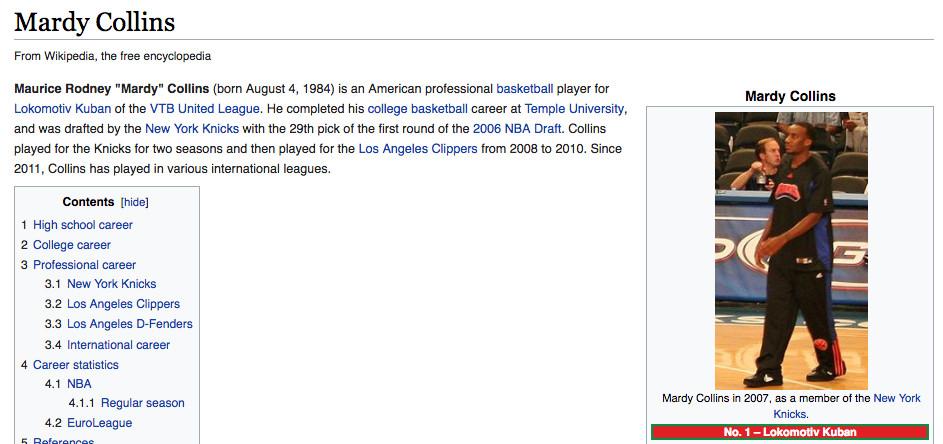
This photo of Mardy Collins is so bad that it isn’t a photo of Mardy Collins. The person pictured looks like Walker Russell Jr., the son of a Knicks scout who got a training camp invite before the 2007–08 season. Russell doesn’t look much like Collins, but nobody has felt compelled to change the picture since it was uploaded to Collins’s page in June 2013. I think the faraway, indistinct nature of the photo is why. I’m in the intensely small subset of NBA fans who could recognize Collins, and even I looked at the image for a while before thinking, "Hey, wait a second!"
Interestingly, Collins is in the uncropped photo — he’s the player all the way on the right of the shot, two players over from his not-quite-doppelgänger who has represented him on Wikipedia for four years.
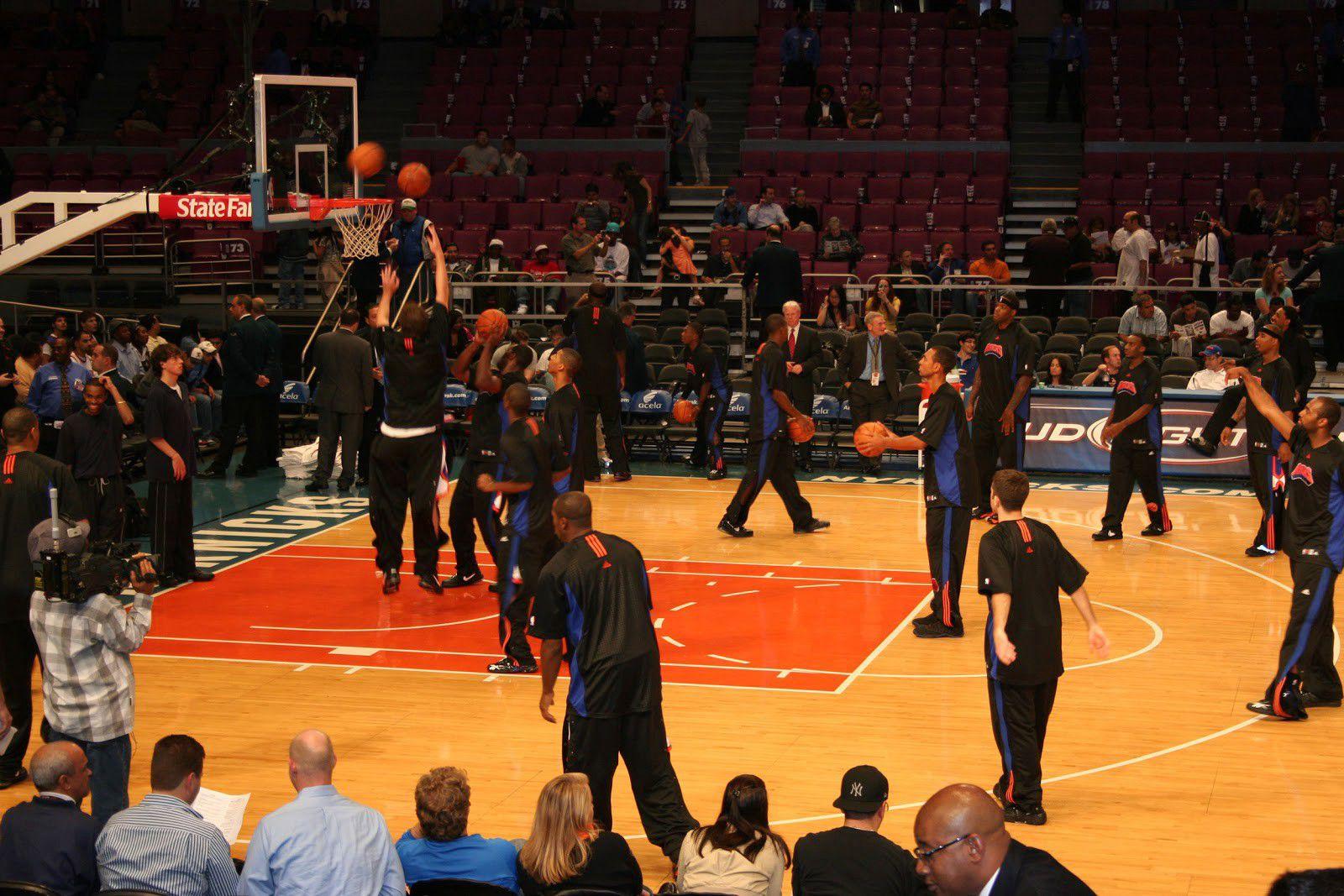
Brevin Knight
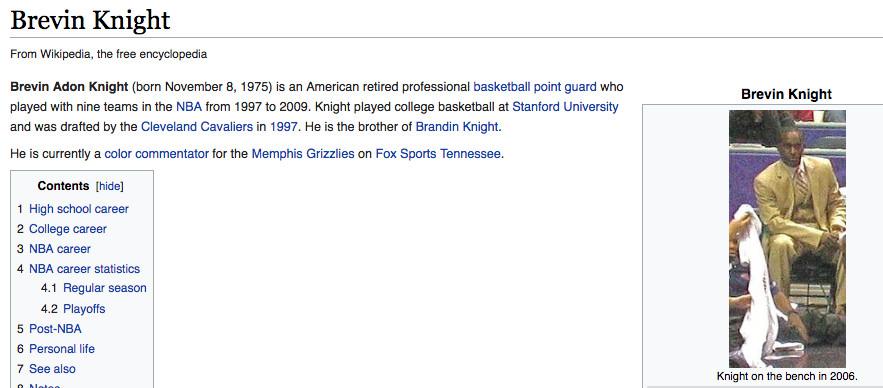
I doubt that Knight wore this gold three-piece suit a lot during his 15-year NBA career. I doubt he wears it a lot now, as a color commentator for the Grizzlies. And yet here he is, showcased on the internet’s most-used database not as someone who played basketball, but as someone who once sat near a game wearing a metallic disaster. The lack of clarity on Knight’s face makes this look like a wanted poster put out by the fashion police.
Let’s look at the uncropped picture.
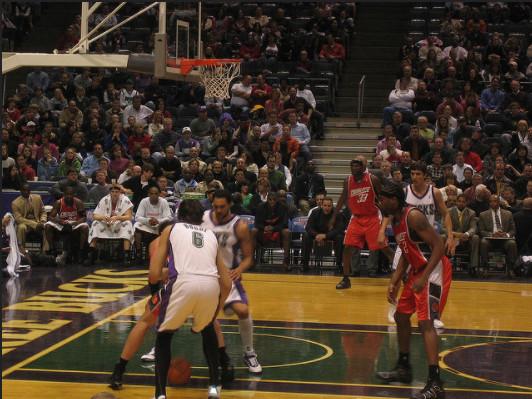
See Knight? Even in his shiny outfit, it’s still hard to notice him sitting aaaaaallll the way at the end of the bench. That didn’t stop somebody from cropping out everyone but Knight and making him the star of the picture.
The original shot is the work of a Flickr user named Jeramey Jannene, who uploaded many photos from Bucks games in the mid-2000s. Somehow, Jannene’s collection has become the source of a treasure trove of Wikipedia images of players sitting on benches. Let us begin a compendium of Jannene’s greatest work:
Maurice Taylor
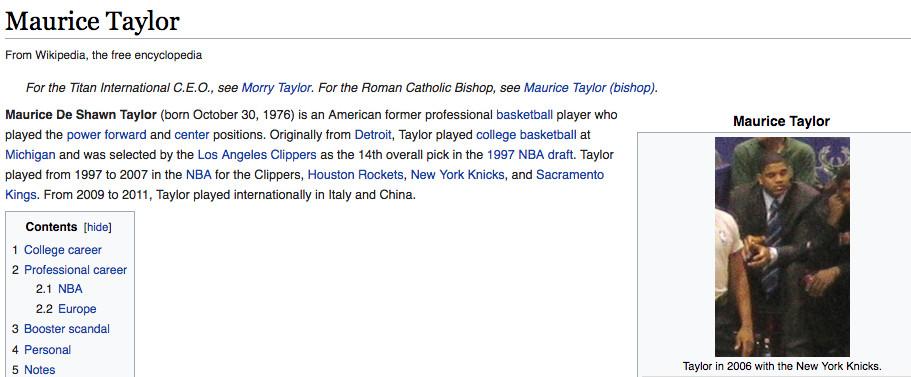
This image comes from a picture Jannene took of Mo Williams shooting a free throw. As with Knight in his Wiki thumbnail, Taylor is sitting all the way at the end of the bench in the original.
Jackie Butler

This comes from … the same image of Mo Williams shooting a free throw. One picture, two unsuspecting guys on the bench cropped and exhibited to the world.
Reece Gaines
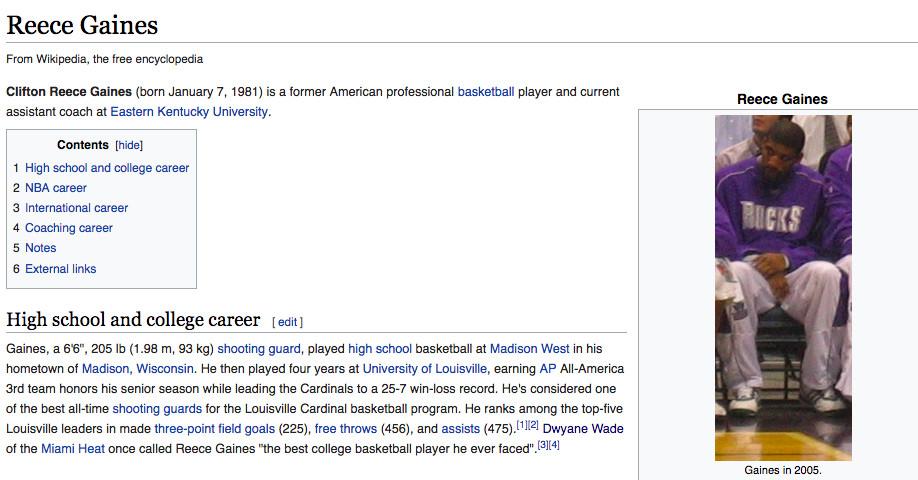
This one comes from the picture of Shandon Anderson’s back.
Jannene probably didn’t intend for this to happen. It seems like he was just a kid with good seats and a not-so-good camera who took pictures and put them online. Jannene might not even know that his age-old pictures have been repurposed for Wikipedia glory, a process that happened years after he uploaded them. The shot of Knight was taken on February 11, 2006. It wasn’t cropped and uploaded to Knight’s page until July 8, 2011. The shot of Butler and Taylor was taken on March 4, 2006; it didn’t make Butler’s page until January 16, 2012, and it didn’t show up on Taylor’s until March 25, 2014. (The user who uploaded it noted it was a "better photo" — and to be honest, it actually is better than the last picture on Taylor’s Wiki page.)
Regardless, Jannene is the the King of Wikipedia Photos of NBA Players Sitting On Benches. Without him, countless players would remain undocumented.
Kenny Thomas

Poor Kenny Thomas. It’s not just that the quality of this picture is absolutely awful — the lighting is terrible, Thomas is wildly out of focus, and there’s no clear indication where his head turns into his neck. It’s also the situation in which the photo was taken.
This shot is from 2006, at a fan appreciation event for the Kings. Thomas probably met the fans, had some fun, and at one point was asked to serve ice cream. It may have been slightly humiliating, but whatever. For a few minutes, how bad could it be?
Eleven years later, this is the moment that has been chosen to encapsulate Thomas’s 11-year NBA career, in which he also played stints for the Rockets and 76ers. He scored 5,876 points, grabbed 4,341 rebounds, and scooped maybe 10 to 20 scoops of ice cream. And yet here we are, admiring Kenny Thomas, professional ice cream scooper.
Larry Brown
Brown has coached 2,703 games: 2,002 in the NBA, 365 in college, and 336 in the ABA. How is this the best picture the public domain had to offer?

Brown wears glasses, typically with thick rims, and has done so for decades. Here’s an AP shot of him at Kansas in 1983. Here’s an AP shot of him at SMU in 2016. You probably thought you saw those glasses on this Wiki image because you’re so used to seeing Brown wear them. But I don’t think there’s a single pixel here that suggests the presence of eyewear. Maybe there’s a slight trace near his right eye?
Of course, the main way to avoid a blurry picture is by staying still. Unfortunately, Brown switched jobs almost every year for 30 years.
David Wesley
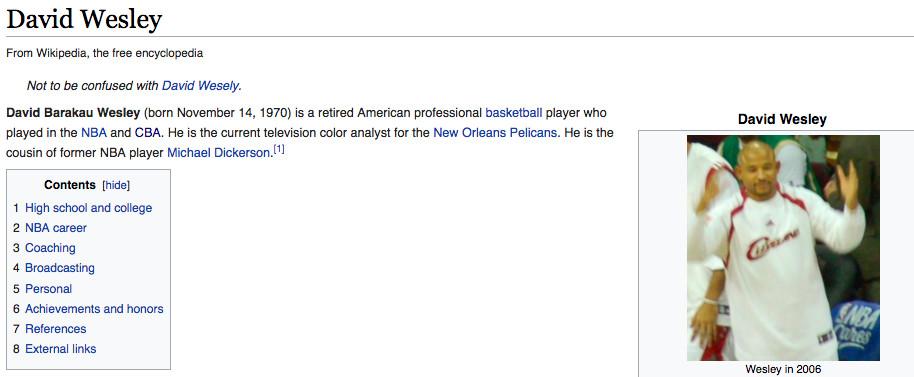
Wesley averaged a double-digit point total every season from 1995–96 to 2004–05, and barely missed the mark by averaging 9.9 points in 2005–06. Then he spent 2006–07, the final season of his career, as a benchwarmer for young LeBron’s Cavaliers. Sadly, that’s the Wesley captured on his Wikipedia page. He’s not dribbling or shooting. Instead, he’s seemingly celebrating a play made by Boobie Gibson, Damon Jones, or one of the other forgettable players on that team who got minutes ahead of him.
I have no idea what this celebration is. Maybe Wesley was demonstrating the size of a fish he caught, or launching into an absurdly big clap, or maybe he’d forgotten what sport was being played and he was preparing to signal TOUCHDOWN. No matter what the explanation is, it’s clear why he fell off this season — he must have lost most of his shooting touch when his right hand became permanently blurry, losing all form and boundaries.
This shot genuinely resembles the Mr. Krabs meme, with the character off-balance, one hand positioned slightly higher than the other, and everything out of focus except the face and upper body. And yet go to Mr. Krabs’s Wikipedia page; he looks perfectly normal. A shame.
Danny Fortson
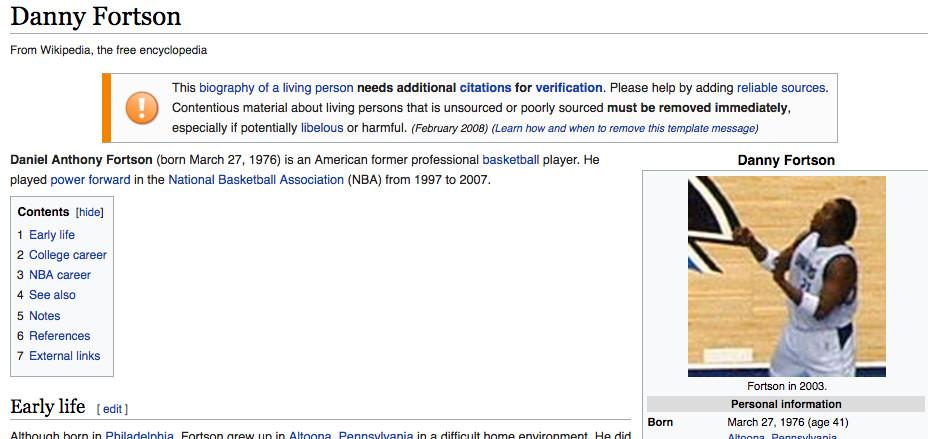
This picture of Fortson looks like an artifact from the period before humans figured out how to create images incorporating three-dimensional perspective. It would fit on an Egyptian cave wall, or stitched onto the Bayeux Tapestry. Some ancient king probably demanded his finest artisan capture the essence of a presaged power forward who would one day average 11.2 points per game for the 2001–02 Warriors. The artist tried his best, but quickly came to the conclusion: "Dammit, I don’t know how to do faces. I’ll just have Fortson look to the side. And wait, how do arms go?"
Making this photo even stranger, it was cropped from a shot apparently taken from a space shuttle:
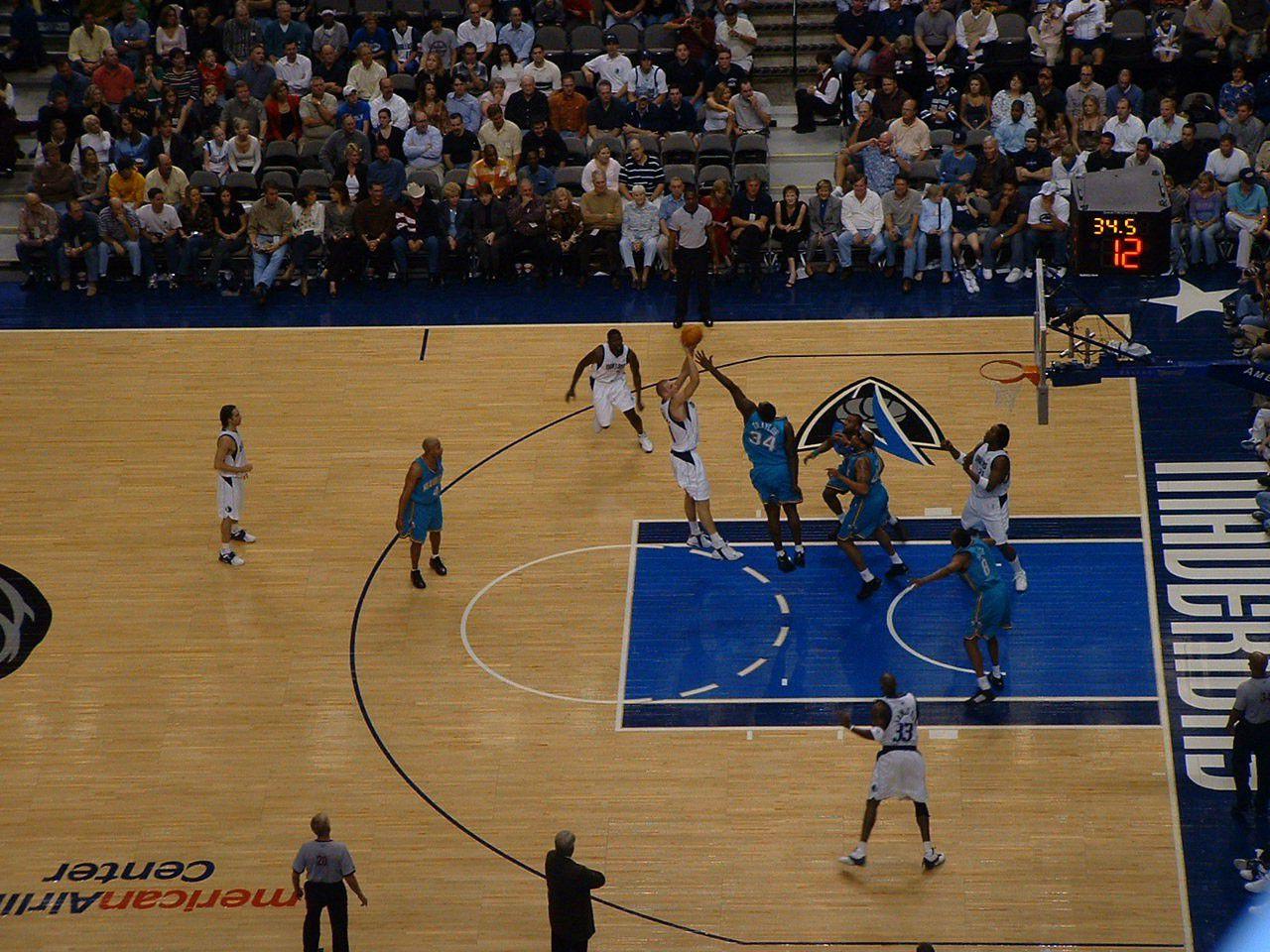
Honestly, it’s cool to see a satellite image of an NBA game. I’ve never seen anything like it, since games are normally played in arenas with roofs.
Ryan Bowen
Here, at long last, is never-before-seen evidence that Sasquatch is real — and that he wears teal.
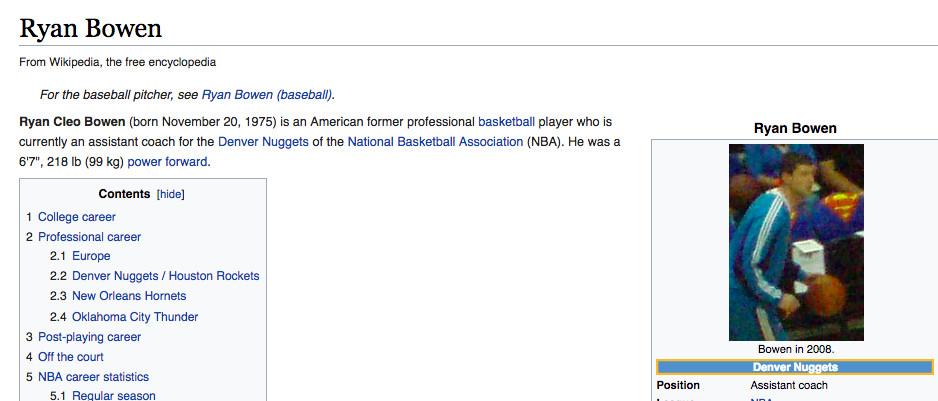
This is an URBO — an Unidentified Ryan Bowen–like Object. If I’m interpreting this photo correctly, Bowen left an NBA game with a basketball and his warm-ups, robbed a 7-Eleven, and soon became one of the most elusive backup power forwards turned bandits this country has ever seen. His Wikipedia page shows an image of him that security cameras must have captured, and police want you to keep an eye out for any suspicious-looking 6-foot-7 men clad in turquoise jumpsuits.
Here, I Photoshopped Bowen into the famous pointillist painting A Sunday Afternoon on the Island of La Grande Jatte by Georges Seurat.
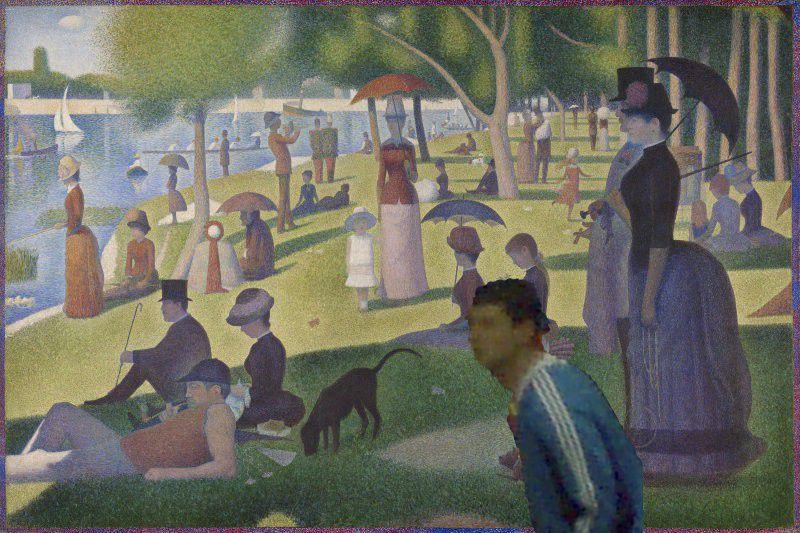
Bowen’s photo has to be the worst NBA player image that exists on Wikipedia. It reveals no distinctive facial features that indicate what Bowen actually looks like. (I think I see an ear!) In the original picture, taken roughly 3.2 nautical miles away, Sean Marks is blocking Bowen’s legs.
Wikipedia would be fine without this photograph of Bowen — or, for that matter, any photograph of Bowen. Hell, I could just Google Bowen’s name if I really needed to know what he looks like. But some anonymous internet hero scoured the web, found this long-lost image with a splotch of color that might be Bowen, and uploaded it to his page. That effort — that valiant, failed attempt to share knowledge with the world — is so much more meaningful than a clear image of Bowen could ever be.
When I look at this picture, I don’t see Ryan Bowen — mainly because the packet of pixels on the screen doesn’t resemble Ryan Bowen in any way, shape, or form. I see love.
